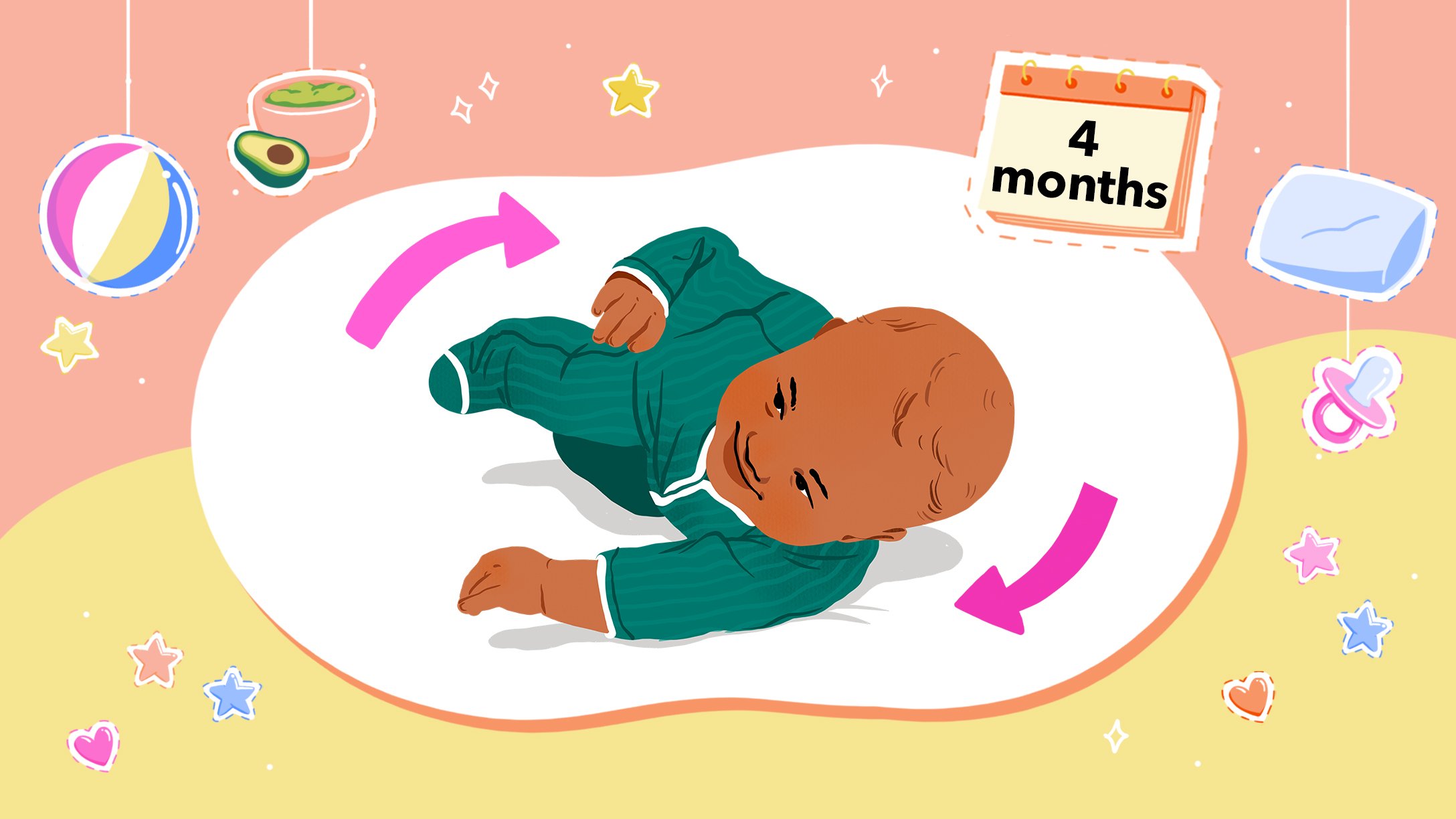
Your baby at four months loves to play and laugh. What else is your baby up to these days? Drooling, putting your keys and any other item within reach into their mouth, smiling ear to ear when you walk in the room? Or maybe showing off their new rolling and pushing-up skills? Your baby is a social creature — playing with them is just going to get more and more fun. Find out what else your 4-month-old is all about in the rest of the article.
Your 4-Month-Old’s Milestones
At 4 months, your baby’s weight has just about doubled. Their head is stronger and able to stay upright. Your baby likely has started rolling — but if they haven’t, remember that babies roll over at all different ages — just make sure yours is getting lots of time on the floor to move and exercise. Listen for coos and babbles as your baby starts to express themselves verbally.
Regarding their movements, the American Academy of Pediatrics (AAP) lists these other 4-month-old milestones:
- Establishing muscle control to coordinate their eyes and head movements.
- While on their tummies, they can raise their head, push up on their arms, swim with their arms, and rock from their tummy to their back.
- Strengthening their back and neck muscles and developing better balance in their torso, head, and neck.
Your 4-Month-Old’s Development
According to the World Health Organization, the average baby weight and height for a 4-month-old is 14.1 pounds and 24.4 inches for girls and 15.4 pounds and 25.2 inches for boys. In general, your baby will gain about 1 to 1.25 pounds and be about 1 inch longer than last month. Remember to focus on the fact that your child is growing healthily and not emphasize the percentiles. Your baby’s height and weight are not grades, and there is a wide range of normal.
Please contact your child’s pediatrician if your baby shows any of the following signs of developmental delay at four months, such as:
- Doesn’t track things as they move.
- Doesn’t smile at people.
- Can’t support head or keep it steady.
- Doesn’t babble or make sounds.
- Doesn’t try to put things in their mouth.
- Doesn’t try to stand or bounce or push down with legs when feet are placed on a firm surface.
- Has difficulty moving one or both eyes in all directions.
Note: If you are visiting a medical professional during COVID, make sure to ask about the facility’s safety measures and confirm that they are following COVID protocols as indicated by the Centers for Disease Control and Prevention (CDC).
A General Schedule for Your 4-Month-Old
Gone are the days when your baby just sleeps all day. Your 4-month-old wants to play and interact with you, and you’re likely both endeared and at your wit’s end because what exactly are you supposed to do with a 4-month-old all day? Don’t worry so much — whatever you do, whether it’s sing, read, or even just chat while you carry them in the baby carrier or sling — as long as your baby is healthy and safe, they’ll develop just fine. (Plus, it’s literally the first time they’re doing anything, so you can’t possibly disappoint them.)
Here is one suggested routine:
- Morning: feed, play, feed, nap
- Afternoon: play, feed, nap, play
- Evening: feed, nap, play, bath (not necessarily daily), story or lullaby
- Night: feed, sleep, feed, sleep
Feeding and Eating Guidelines

A baby’s growth booms in the first three months of life, so yours will add weight more slowly now. At this point, the amount of milk a baby takes in doesn’t change very much. Breastfeeding newborns tend to increase their consumption of milk until about 3 months, and then plateau, says Wendy Haldeman, R.N., lactation consultant and cofounder of The Pump Station in Los Angeles. “In the first three months, human babies need lots of energy to stay warm, but once a baby has developed enough brown fat to stay warm, she can now use those calories for growth.”
Tempted to try solid foods? It’s an exciting prospect and a fun new chapter for you and your baby. Here are some signs that your baby may be ready soon for solid foods:
- Can hold head up and for long periods.
- Can sit up (while propped) in a high chair.
- Doubled birth weight and is at least 13 pounds.
- Interested in food and opens mouth to try to eat.
Check with your pediatrician, as most experts will recommend holding off another month or two. Your baby’s nourishment is fulfilled by breast milk or formula at this age.

Kung – Korbkarn Limsombatanan
“The American Academy of Pediatrics recommends starting solid foods at 6 months of age,” Dr. Steph Lee, spokesperson for the American Academy of Pediatrics, told Mom.com. “Before 6 months of age, babies may not hold their head steady enough or have enough tongue coordination to mash and swallow solids.”
Dr. Lee also advised against giving the baby any water because breastmilk and formula have enough water. “Water has no calories and can make a baby feel full without the necessary nutrition,” she said.
Play: Toys, Games, and Activities

Kung – Korbkarn Limsombatanan
The best place for your baby — when they’re not in your arms or on the go — is on the floor, and especially on their tummy.
It sounds silly to say this, but it’s a good reminder: It’s OK to leave your baby to entertain themselves if they’re content. Working on shaking a toy, rolling around or just watching a shadow on the wall — it’s actually a good idea to let your baby have some alone time (with you nearby).
Some other activities you can play with your 4-month-old include:
- Peekaboo
- Hide a toy or object (poorly) and have your baby find it.
- Let them explore child-safe objects that have different textures, weights, shapes, and sizes.
- Play with bubbles.
Sleep and Nap Guidelines

Kung – Korbkarn Limsombatanan
At four months, your baby should be sleeping about 10 hours at night (including waking to feed) and napping around five hours spread over two to three naps during the day. However, you may also have a formerly good sleeper who now wakes up multiple times a night. That’s the dreaded “sleep regression,” and it often rears its head between 3 to 5 months.
“When babies get a burst in cognition and consciousness around this age, it’s common for sleep to get very bumpy,” said sleep consultant and author Heather Turgeon. “In our practice, we hear parents saying all the time, ‘She thinks she’s a newborn again!'” It’s normal, and the silver lining is that it means you have an aware and smart baby on your hands.
Try to ride the wave and avoid adding in lots of extra bouncing, feeding, rocking, and so forth, says Turgeon. The mistake many parents understandably make is starting to do all these new habits and soothing tricks they didn’t need before — the baby gets quickly addicted. Of course, you want to help and soothe your baby, but the key is to help them just enough and gradually fade that help so they can take over.
Should you “sleep train” your baby? Turgeon says that depends on what you mean by sleep training. It’s still very natural for babies to wake up and feed at this age, so it’s too early to think about weaning, and breastfeeding moms’ milk supply can be seriously dented by too-early night weaning. In her sleep consulting practice, Turgeon likes for parents to hold off on structured sleep plans until the baby is about 5 months old (depending on the maturity of the baby), and even then babies can still keep feedings in place while you’re working on self-soothing skills to improve overall sleep.
Here are some signs your baby may be ready for sleep training:
- They eat a lot more and have gained weight.
- Have naturally dropped a night feeding or two.
- Decreased Moro (startle) reflex.
- Your baby has gotten into a regular sleep routine.
Common 4-Month-Old Health Conditions
At the 4-month mark, there is generally a 4-month-old checkup appointment with your child’s pediatrician. At the 4-month checkup, the AAP and CDC recommend second doses of the following immunizations:
- Pneumococcal conjugate (PCV13)
- Diphtheria, tetanus, and acellular pertussis (DTaP)
- Haemophilus influenzae type b (Hib)
- Poliovirus (IPV)
- Rotavirus (RV)







